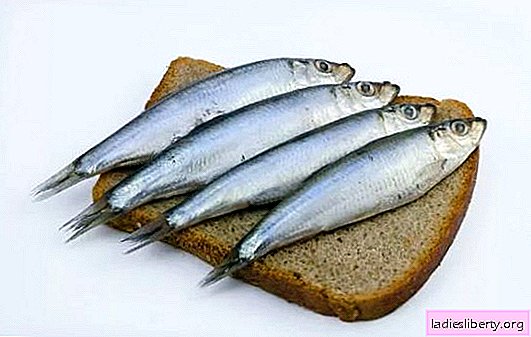
Sprat has become a familiar and indispensable product for many people. The benefits of sprats are undeniable: for the cardiovascular system, for the gastrointestinal tract, for blood composition.
Sprats are called the mass of a variety of small fish species that swim in the seas in flocks and in length reach no more than 15-17 centimeters. Each such fish weighs about 55 grams, and its life expectancy does not exceed three to four years. There is no harm from the sprat, except in the cooking features.
For whom the sprat is harmful
Various canned foods are mainly prepared from small fish: sprats, sprats in tomato sauce and sprats in oil, pate. It is smoked and salted. For people suffering from diseases of the gastrointestinal tract: ulcers, gastritis, pancreatitis and other diseases of the pancreas, intestinal diseases - sprat is harmful.
This is due to the large amount of salt, vinegar, spices and other products that are used to preserve this fish. Such products irritate the gastric mucosa and may cause ulcers to open.
Such products are especially contraindicated in young children, as their stomachs are not able to digest without consequences a large number of spices and spices, especially smoked products.
Why sprat is harmful
Smoked fish in itself is already a heavy product that cannot be consumed in large quantities due to its high percentage of tannins and other derivatives. This happens when the fish is in contact for a long time with smoke, which contains a lot of resins. A small fish is impregnated with these substances and then the sprat is harmful to the human body.
Sprat, eaten in large quantities, in the form of canned food will bring considerable damage to the body: dehydration, further swelling, cramps are possible. Therefore, canned foods must be consumed sparingly and not often.
What good is the sprat?
Sprat is a useful and necessary product in the human diet. It is fried, boiled, stewed, pies are made from it, using as a filling. Sprat is rich in polyunsaturated fatty acids, which contain up to 3 grams in each portion of fish per 100 grams. Like any saltwater fish, the sprat contains Omega 3. Its regular use in food lowers blood cholesterol, helps in the fight against atherosclerosis, and reduces the risk of blood clots and clogging of blood vessels.
Healthy fats are of great benefit to brain cells, stimulating its work. The cells of the body, being filled with Omega 3, become more durable, elastic, resilient, their ability to withstand free radicals increases. The metabolic processes in the body are stabilized.
Sprats are recommended to be consumed whole: along with the tail fin, bones, skin and scales. It is in the bones of the fish that contains the most much needed calcium, magnesium, and phosphorus.
The use of sprats in a high content of easily digestible protein. It is useful for people after surgery, children, pregnant and lactating women. The building material of all tissues is distributed among the systems and organs of the body, providing cells with protein.
Despite this, sprat is a dietary product. It practically does not contain heavy fats, there are no carbohydrates at all, which is important for people concerned about their own weight. There are 133 calories in a sprat. This fish is often used in the hospital diet for patients who need to follow a diet.
The sprat content of useful trace elements and nutrients
Sprat is rich in a whole range of useful vitamins necessary for the body of minerals, trace elements per 100 grams of fish:
1. 7.4 grams of fat, which is 12% of the daily intake. Of these, 2.9 grams of polyunsaturated fat;
2. 83 grams of cholesterol, which is 28% of the daily allowance;
3. The protein content is 17 grams, which covers a third of a person’s daily need;
4. Sodium 5.000 mg, which is twice the daily requirement of a person;
5. Potassium is contained in an amount of 184 mg - and this is 5% of a person's daily needs;
6. Zinc - 5% of the daily intake;
7. Phosphorus - 33% of the daily dose;
8. Magnesium - 13% of the daily intake;
9. Calcium - 9% of daily needs;
10. Iron - 78% of the daily intake;
11. Vitamins D, B1 and B2, PP.
Sprats - a storehouse of benefits for human health. It is caught in tons and sold among the population. In history, it was so cheap and affordable that in England they fertilized the soil, using instead of fertilizers.
The benefits of sprats for the human body
Sodium controls and maintains the water-salt balance in the human body. If sodium deficiency is detected, then they say about dehydration. A person feels dizzy, nauseous, drowsiness. If there is an excess of sodium, then edema appears throughout the body, especially in the area under the eyes. With the help of sodium, nutrients are exchanged between the cells of the body. Sodium in sprat is sufficient to eat, only 50 grams, to satisfy the daily norm of the body.
Niacin or vitamin B3 promotes the conversion of carbohydrates into energy, is responsible for the integrity of cells, and is involved in controlling blood sugar levels.
Thiamine or Vitamin B1 is essential for metabolism. He takes an active part in the construction of muscle tissue, especially in maintaining the viability of the heart muscle. The strength and endurance of muscles, the ability to receive and give energy directly depend on it.
In ancient times, during the conquest of various islands on which aborigines lived, sailors encountered a mysterious beriberi disease. The patient suffered from convulsions, anorexia, muscle weakness, and eventually died from exhaustion or heart attack. Scientists have found that this disease is entirely associated with a lack of Thiamine in the human body.
The natives ate a lot of fish, including sprats, so they were spared from such a terrible disease. These people have always been very hardy and healthy. The physical capabilities of their body have always surprised Europeans.
Calcium and magnesium are the most important elements in the construction of bone tissue. The health of teeth and bones, nail plates depends entirely on the use of large amounts of calcium and magnesium. In addition, which is very important, these elements are absorbed very well with phosphorus. Sprat contains all these elements, so its use becomes simply necessary for everyone, especially for young children and for older people, whose bones become fragile.
Iron is contained in 100 gm sprats in almost a daily dose. Iron is the most important element in maintaining a good level of hemoglobin in the body. Regular use of sprats will help to avoid anemia, especially in children, in pregnant women, in nursing mothers. Iron is also important for schoolchildren and students for good blood circulation in the brain cells.
Vitamin D is especially important for people who live in northern areas where there is little sunlight. It is this vitamin that supports the necessary amount of calcium in the child's body and does not allow rickets to develop. Sprats are useful for both adults and children. It can and should be eaten daily.











